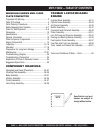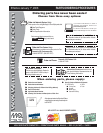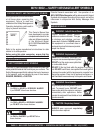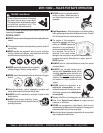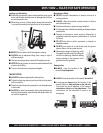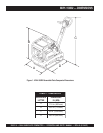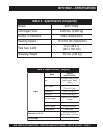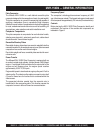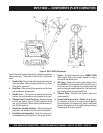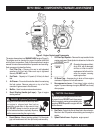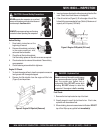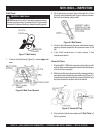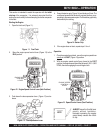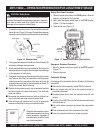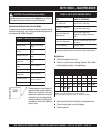
PAGE 12 — MVH-150D2 PLATE COMPACTOR — OPERATION AND PARTS MANUAL — REV. #2 (01/16/07)
MVH-150D2 — GENERAL INFORMATION
Plate Compactor
The Mikasa MVH-150D2 is a walk-behind reversible plate
compactor designed for the compaction of sand, clay and asphalt.
This plate compactor is a powerful compacting tool capable of
applying a tremendous force in consecutive high frequency
vibrations to a soil surface. Its applications include soil compacting
for road, embankments and reservoirs as well as backfilling for
gas pipelines, water pipelines and cable installation work.
Compactor Components
This plate compactor is comprised of an anti-vibration handle,
vibrating case (eccentric), water tank, guard hook, rubber shock
absorbers and a Yanmar diesel engine.
Reversible Vibratory Plates
Reversible vibratory plates have two eccentric weights that allow
a smooth transition for forward and reverse travel, plus increased
compaction force as the result of dual weights.
Due to their weight and force, reversible plates are ideal for semi-
cohesive soils.
Power Transfer
The Mikasa MVH-150D2 Plate Compactor is equipped with an
air-cooled, vertical single-cylinder, 4-stroke Yanmar L48V6 diesel
engine. A centrifugal clutch is attached to the output shaft of the
engine and will engage when the engine speed reaches
approximately 2,300 ~ 2,600 rpm’s.
Engine shaft speed is transfered via engine pulley and V-belt to
vibrator pulley. The vibrator pulley rotates an eccentric rotor shaft
(2) one for foward one for reverse that is contained within the
vibrator case.
The generated vibration created from the eccentric rotor is
transmitted to the compacting plate. This vibration causes the
compactor to move in either a forward or reverse direction.
Frequency/Speed
The compactor's vibrating plate maximum frequency is 6,000
vpm (vibrations per minute). The forward and reverse travel speed
of the compactor is approximately 75ft./minute (23 meters/minute).
Controls
Before starting the MVH-150D2 Plate Compactor, identify and
understand the function of the controls and components as
indicated in Figure 2.



